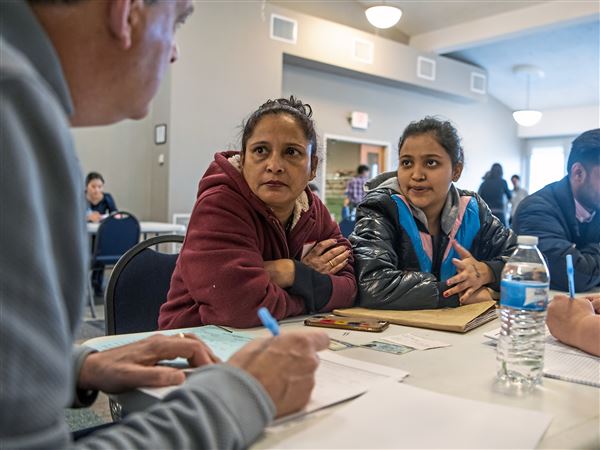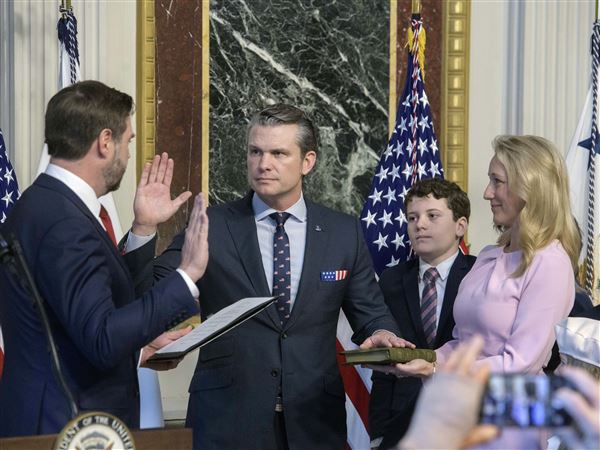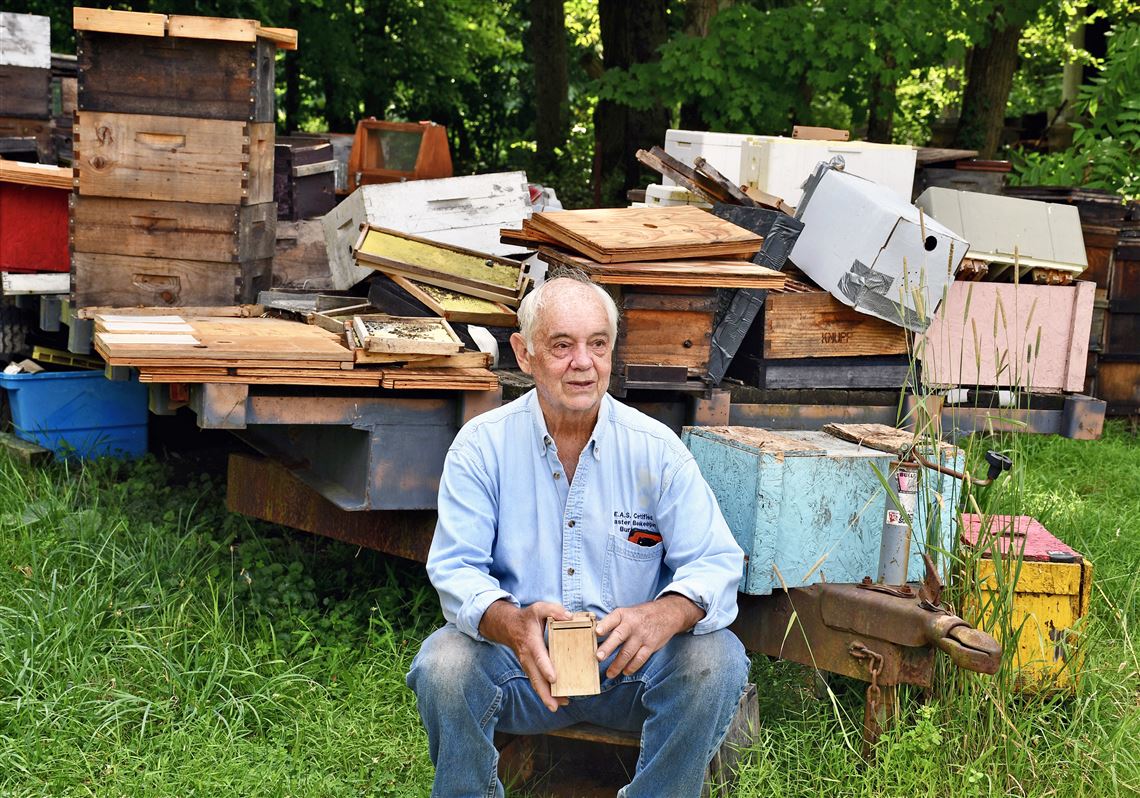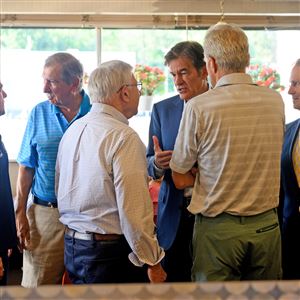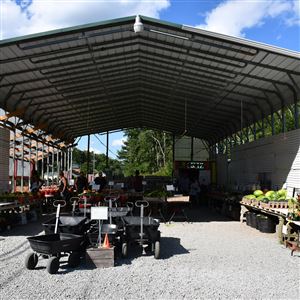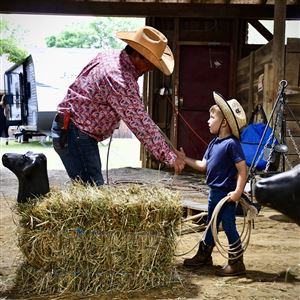NEW FLORENCE, Pa. — Tucked away in a curve of the Conemaugh River not far from Buttermilk Falls, master beekeeper Burl Knupp is checking the hives on his property. Despite not wearing a protective suit, his movements are calm as he makes sure the bees in each hive are healthy and productive.
The bees are surprisingly calm as well. Mr. Knupp estimates there are thousands of them in this colony of mostly female worker bees, a few hundred male drones and of course the queen. They’re all busy foraging for food, storing honey for winter and building combs.
“You have to strike a balance of how often you inspect them; do it too often, and you can stress the entire colony — which can cause them to vacate or kill the queen. Don’t do it enough, you might miss signs something is wrong,” said Mr. Knupp.
On Saturdays from May to November, Mr. Knupp can be found at the Ligonier Country Market selling bottles of his honey named — wildflower, buckwheat, clover, knotweed — based on where the bees have visited. His label reads: “From the Garden of Eden God’s Gift from Flowers to Bees to You.”
He’s usually sold out long before the market closes, and he’s not alone: The U.S. honey industry is thriving. According to the University of California Agricultural Issues Center, the industry was responsible for more than 22,000 jobs, and its total economic output was $4.74 billion.
Penn State entomologist, and recipient of the 2021 National Academy of Sciences Prize in Food and Agriculture Science, Christina Grozinger says in Pennsylvania alone there are more than 6,000 beekeepers. “Most beekeepers collect honey and wax from their bees and can sell it at local markets; by purchasing locally produced honey and wax, you can help your local beekeepers,” she said.
In Pennsylvania, bees not only create jobs — directly and indirectly — they also support the farmers who grow the fruits and vegetables that fill our kitchens. The Pennsylvania Agriculture Department says that over 80% of state crops depend on bees for pollination.
Simply put, beekeepers like Mr. Krupp aren’t just hobbyists; they are an integral part of the agricultural industry. Bees and beekeepers help farmers pollinate their crops and keep our environment healthy.
Honey bees are immeasurably important to our daily lives. No honeybees would mean no us.
Ms. Grozinger explains that bees help move pollen between flowers, which is necessary for flowering plants to make seeds and fruits. “About 80% of all flowering plants, and 75% of our major agricultural food crops, benefit from the work of bees and other pollinators,” she said, “so the next time you are enjoying your morning coffee with a berry muffin, thank a pollinator.”
“The berries and coffee plants require pollination, and most dairy cows eat alfalfa, which requires pollination to make seeds; pollinators are important for plants that we use to make our clothes, such as cotton, and our furniture, such as Black Cherry,” she said.
When honeybees collect nectar from flowers, they bring it back to their hive and process it to make honey. After processing, the honey has antimicrobial properties and can be stored for a long time. The bees make honey so they can store this food and eat it over the winter, but they make enough honey that beekeepers can harvest it and share it with us.
However, about one-third of managed honeybee colonies die each winter in the United States.
Ms. Grozinger said beekeepers are very careful and resourceful. They split their colonies each spring and summer to make more of them, which means we have enough honeybee colonies to pollinate our major food crops.
“Wild bees, flies, butterflies, moths and beetles are also important pollinators of crops, and can do all the work of pollination in farms that are close to the natural habitat where they live. However, wild pollinator populations are also showing declines across the country and the world,” she explained.
If these declines continue, it may be difficult to pollinate some of our crops, which would result in increased prices or require more land to produce the same amount of food. Mr. Knupp said he lost over 40% of his bees last year, and there has been a dramatic decline in the bee population at fruit farms in Pennsylvania for over a decade.
Ms. Grozinger, who studies the factors causing global population declines in honey bees and other pollinators, says that while the collapse that made headlines ten years ago isn’t getting that same attention today, the problem has not gone away.
Fifteen years ago, beekeepers in Pennsylvania were stumped when their perfectly healthy hives became barren overnight. The mystery became known as “colony collapse disorder,” and it spread across the country. Between 2008 to 2013, wild bee populations plummeted by 23%.
There weren’t even any dead bodies to study; they were just gone. It’s a mystery Ms. Grozinger said has never been fully solved.
Twelve years ago, it was estimated that if a beekeeper experienced a complete loss of 200 honeybee colonies, the economic impact on the agriculture would be almost $5 million, a staggering number that illustrates the impact they have on in our rural communities.
Ms. Grozinger says bees are tremendously fascinating creatures: “Honeybees live in colonies with a queen and tens of thousands of worker bees. These worker bees are the queen’s daughters, and they do not lay their own eggs — instead, they help rear the queen’s offspring which are their sisters and brothers.”
Bees are amazing examples of cooperative behavior; they all work together to ensure the colony has enough food to rear the baby bees and to survive the winter.
“The workers even tell each other where to find flowering plants through a symbolic dance language, which gives information on the distance and direction of the flowers relative to the hive entrance. However, most bee species are solitary, so there is a single, hardworking mother bee that builds the nest, collects the food for her babies, and defends the nest,” she explained.
Pennsylvania has more than 400 wild bee species and they come in different shapes, sizes and colors. While many of us may shrink in fear when hearing a nearby buzz, bees are vital to the prosperity of rural America and to our food supply. Without them, simply put, we would not survive.
North Side native Salena Zito is a national political reporter for The Washington Examiner, a New York Post columnist and co-author of “The Great Revolt”: zito.salena@gmail.com.
First Published: August 21, 2022, 4:00 a.m.

